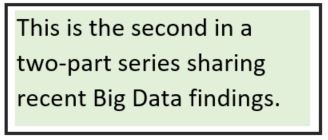
Big Data: Does technology level make a difference?
Sometimes the simple questions are the toughest ones to answer.
I suspect most HCPs would agree that choosing the most appropriate technology level for a patient is not always clear cut. Matching technology level to a patient’s hearing needs requires insight into their lifestyle, as well as an understanding of how different technology levels will perform in their unique listening environments.
 This question becomes even more complex with the continual innovation of technology. It can be hard for HCPs to stay current when manufacturers are constantly introducing new versions of technology levels that include different features.
This question becomes even more complex with the continual innovation of technology. It can be hard for HCPs to stay current when manufacturers are constantly introducing new versions of technology levels that include different features.
It reminds me of an experience earlier in my career when I worked in a clinic. I recall conducting a hearing aid evaluation for a woman who lived in a residential home. I was keen to make sure we discussed her lifestyle and the expected benefits of different technology levels. She described a very simple lifestyle – due to mobility issues, she spent her days watching television in her room, only leaving to go to the dining hall for meals. Together, we agreed that a mid-technology level BTE would be sufficient for her hearing needs. To me, I asked all the right questions to ensure we were choosing the right hearing aids.
Well, two weeks later she returned unhappy with the performance of her hearing aids. She reported that her hearing improved overall but she was still having difficulties understanding her friends in the dining hall. Since she was a social person, this was impacting her quality of life.
When I probed further, she mentioned that the dining hall was very busy and the 8 people at her table were very chatty. She complained that she couldn’t always hear what her friends were saying from across the table. The hearing aids I had originally fit her with were equipped with a ‘comfort in noise’ feature but it was clearly not enough. I decided to trial her with higher technology level hearing aids which had a feature specifically designed to improve speech understanding in noise.
I was nervous before her follow-up visit because I feared she might be disappointed again. Fortunately, this was not the case. She returned to my clinic as a satisfied hearing aid wearer and did nothing but praise my abilities as a clinician after that. Whether or not I deserved the praise is debatable, but for me, this was a clear example of the benefits of higher technology versus lower technology.
But does higher technology level always mean a happier patient?
Interestingly, there is independent research which does not support that premium level technology provides better outcomes than basic level technology in real world experiences.1 Further research needs to be done to explain this disconnect, but I think Big Data can shed some light on this topic from a different perspective.
Recently at Phonak, we looked at data from ~500 participating clinics and performed a routine investigation to compare wearing times for different technology levels. Based on a sample of almost 200,000 fittings, the findings showed wearing time for premium products to be 1.4 hours per day more than basic technology.
So, how do we interpret these findings? What does longer hearing time mean for hearing aid wearers? Does it mean those who wear higher technology hearing aids are more satisfied? Of course, with big data analysis, we aren’t given the ‘why’, but as an audiologist, I believe more hours of hearing every day is a very good finding.
As referenced in my first blog post in this series, here is the infographic showing what we found.
1Cox, R., Johnson, J., & Xu, J. (2016). Impact of hearing aid technology on outcomes in daily life, I: The patient’s perspective. Ear & Hearing, 37(4), 224-237.
